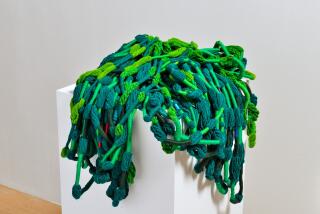Jerome Ackerman, who stood at the heart of L.A.’s Midcentury Modernism movement, dies at 99
Jerome Ackerman, a gregarious designer-craftsman whose artistic collaboration with his wife, Evelyn Ackerman, was at the heart of California’s Midcentury Modernism movement, has died at his longtime home in Culver City.
Ackerman died March 30 — two months after celebrating his 99th birthday — of complications from pneumonia, his daughter, Laura Ackerman-Shaw, said.
The multitalented couple moved from their native Detroit to Los Angeles in 1952, when a postwar housing boom offered exciting opportunities to create functional and decorative works in tune with the “California look.” The new lifestyle called for airy indoor-outdoor spaces enhanced by artful modern furnishings, and the Ackermans were up to the challenge.
With a goal of making affordable objects, Ackerman — known as Jerry -- began as a potter, but increasingly focused on the business, expanding production with the help of fabricators from Mexico, Japan, Italy and Greece, and developing the market for their wares. Evelyn, who died in 2012, became a remarkably versatile artist who added a playful spirit to the purity of the Modernist aesthetic.
“The Ackermans lived the designer-craftsman ethos to its fullest extent,” curator Glenn Anderson wrote in the catalog for “Living in a Modern Way: California Design 1930-1965,” a major exhibition at the Los Angeles County Museum of Art in 2011-2012.
Operating under the name ERA Industries, the couple worked in a bewildering range of media: woven and hooked tapestries and rugs, carved wood panels, enamels, aluminum sculptures for architectural settings, cabinet hardware, and mosaic plaques and tables.
Ackerman proved to be a savvy businessman, said Gerard O’Brien, the owner of Reform Gallery on Melrose Avenue.
“He looked at the architecture and design and saw that it could use the warmth that textiles and other products could bring. He understood how to be a merchant and became a vital part of the community. It was a role he took very seriously.”
Born Jan. 29, 1920, in Detroit to Louis Ackerman and Esther Greenberg, Ackerman enrolled as an art major at what’s now Wayne State University but left in 1941 to serve in the military during World War II. He married Evelyn Lipton, a fellow art student, in 1948, and returned to Wayne State in 1949 with financial aid from the GI Bill. The next step was graduate school at New York State College of Ceramics at Alfred University, where he received a master of fine arts degree in 1952.
The Ackermans met Los Angeles’ leading ceramicists as newlyweds, while visiting his parents, who had moved west. But their life-changing decision to relocate came in 1949, when they saw the work of Los Angeles-based designers Charles and Ray Eames in “For Modern Living,” an exhibition at the Detroit Institute of Arts.
The couple opened their first business with a line of ceramics at Jenev Design Studio in West Los Angeles and subsequently offered a wider array of handcrafted goods at ERA Industries on Beverly Boulevard. Ackerman, a consummate salesman, often worked with prominent architects and interior designers and became an expert at adapting production methods to handmade objects.
Highly visible artists, he and his wife participated in every edition of the influential California Design shows at the Pasadena Art Museum, from 1954 to 1976. Their work was the subject of exhibitions at the Mingei International Museum in San Diego and the Craft and Folk Art Museum (now Craft Contemporary) in Los Angeles and is in the collections of many museums, including LACMA and the Smithsonian American Art Museum in Washington.
Ackerman is survived by his daughter; son-in-law Marc Shaw and grandson Aaron Shaw and his wife, Kristen Meister.
Muchnic is a former Times art critic
More to Read
Start your day right
Sign up for Essential California for the L.A. Times biggest news, features and recommendations in your inbox six days a week.
You may occasionally receive promotional content from the Los Angeles Times.






